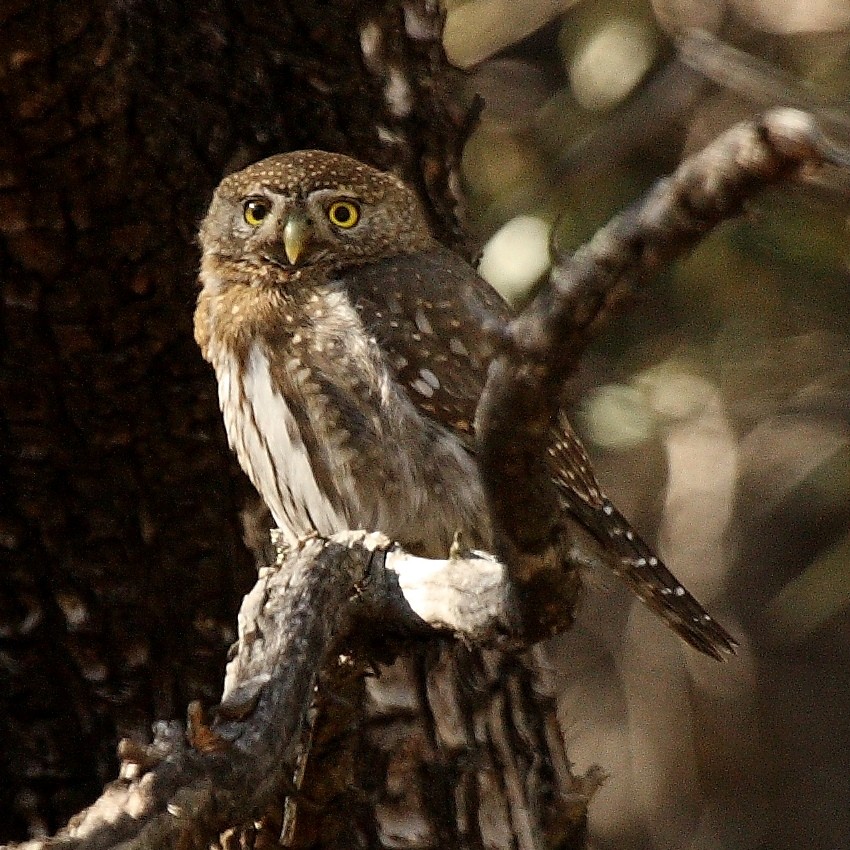Northern Pygmy-owl
A species of Pygmy-owls Scientific name : Glaucidium gnoma Genus : Pygmy-owls
Northern Pygmy-owl, A species of Pygmy-owls
Botanical name: Glaucidium gnoma
Genus: Pygmy-owls
Content
Description People often ask General Info
 Photo By dominic sherony , used under CC-BY-SA-2.0 /Cropped and compressed from original
Photo By dominic sherony , used under CC-BY-SA-2.0 /Cropped and compressed from original Description
The mountain pygmy owl (Glaucidium gnoma) is a small owl from Central America. It is considered a distinct species by some authorities, including the International Ornithologists' Union. Others, including the American Ornithological Society, consider to be a subspecies of northern pygmy owl. If considered conspecific, the scientific name G. gnoma is usurped by the northern pygmy owl. The Northern Mountain Pygmy Owls’ habitats range from coniferous forests to deciduous bottomlands, and despite its large geographic distribution, “it is one of the least studied owls on the continent” (Holt & Peterson 2000). Its diet consists of small birds and mammals, and it has a reputation of being a fierce hunter. This species of owl will nest in natural cavities and in ones created by woodpeckers (Holt & Peterson 2000). In a study conducting research on Northern Mountain Pygmy Owls preferred habitats in the Rocky Mountains, it was discovered to prefer large diverse forests with trees near a stream because it offered protection from predators and camouflage for ambush attacks (Jageman et. al. 2018). 
Size
18-19 cm (7-7.5 in)
Colors
Brown
Black
Gray
White
Life Expectancy
7 years
Nest Placement
Cavity
Clutch Size
2 - 7 eggs
Feeding Habits
Northern Pygmy-owl primarily feed on a variety of small birds, small mammals, insects, and reptiles. Their prey includes hummingbirds, chickadees, warblers, sparrows, shrews, moles, chipmunks, beetles, butterflies, crickets, dragonflies, lizards, and skinks. Notably, they sometimes hunt prey larger than themselves, such as Northern Bobwhite and California Quail.
Habitat
Northern Pygmy-owl dwells mainly in open coniferous or mixed woods and wooded canyons, varying from deciduous woodlands by streams to high-elevation forests near timberlines. They adapt to both temperate regions and tropical highlands, inhabiting environments that include cottonwood, aspen, and mixed-conifer to fir, spruce, pine-oak, and cloud forests. In winter, northern Pygmy-owl may migrate to lower elevations and occasionally urban areas.
Nest Behavior
Northern Pygmy-owl's nesting period aligns with spring, laying eggs directly on cavity debris. Parental care involves both partners, with the female primarily incubating and the male providing food.
Nest Characteristics
Northern Pygmy-owl utilizes pre-existing tree cavities, often at mid-to-high elevations, with no additional construction. Debris like wood chips or decomposing leaves serves as the nest base, occasionally lined with feathers or bark strips.
Dite type
Avivorous
People often ask
General Info
Feeding Habits
Bird food type
Bird Feeder Type

Platform
Sounds
Song
Recording location: Mexico
Behavior
Northern Pygmy-owl exhibit diurnal tendencies, predominantly hunting by daylight. They maneuver through the air with a distinct flight pattern resembling woodpeckers. During the breeding season, they display monogamous behaviors, with males courting females via a resonant tooting call at nest entrances. While females are exclusive incubators, males provision both female and offspring. Their existence is threatened by larger predatory birds and certain mammals. Interestingly, smaller birds often boldly mob northern Pygmy-owl, despite being their typical prey, perhaps dissuaded by deceptive eyespots on northern Pygmy-owl's nape.
Species Status
Not globally threatened.
Scientific Classification
Phylum
Chordates Class
Birds Order
Owls Family
True owls Genus
Pygmy-owls Species
Northern Pygmy-owl